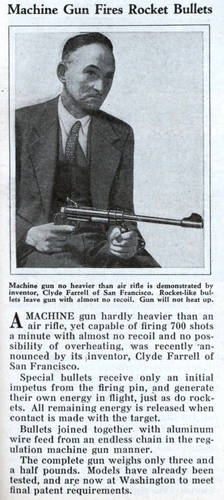The July 1934 issue of Modern Mechanix featured Mr. Clyde Farrell’s Rocket Machine Gun invention, more than 30 years before the first commercially available rocket gun, the GyroJet pistol, went to market. From Modern Mechanix …
A MACHINE gun hardly heavier than an air rifle, yet capable of firing 700 shots a minute with almost no recoil and no possibility of overheating, was recently ‘announced by its inventor, Clyde Farrell of San Francisco.
Special bullets receive only an initial impetus from the firing pin, and generate their own energy in flight, just as do rockets. All remaining energy is released when contact is made with the target.
Bullets joined together with aluminum wire feed from an endless chain in the regulation machine gun manner.
The complete gun weighs only three and a half pounds. Models have already been tested, and are now at Washington to meet final patent requirements.
It was light, had a high rate of fire, no recoil and belt fed. The weapon seemed to good to be true, so I did some investigating. I could find no rocket machine gun patented in the 1930. There are some patents related to rocket machine guns in the late 1940s, but they are for large caliber conventional military rockets designed for aircraft. In fact, I was unable to locate any USTPO patents that were filed by, or listed the inventor as, “Clyde Farrell”.
The claims of being belt fed seem very unlikely. A belt fed weapon needs a power source capable of pulling in rounds and ejecting the empty case and belt links. In magazine weapons this energy is provided by the magazine spring. Belt fed weapons are either powered by gas, recoil or by an external electrical power source. Unlike conventional ammunition, which burns all its propellent inside the barrel, a rocket burns most of its propellent outside the barrel while in flight, thereby generating very little energy inside the gun. The Gyrojet rockets left the gun at just 20 ft/sec! It would not be able to generate enough momentum inside the gun to pull in rounds as well as cocking the hammer. The Grypojet was so slow you can see the rocket bullet leave its barrel in the below video.
Another detail from the article that seems unlikely is the claim that the rocket was ignited by an impulse from the firing pin. If the firing pin was behind the rocket, the hammer would also need to be behind it. If this was the case, how would the rocket cock the hammer? The Gyrojet had a fixed firing pin. Its hammer was in front of the rocket and pushed the rocket into the firing pin. After the rocket was ignited, it pushed the hammer forward as it left the barrel, recocking the gun.
So in summery: the design appears to be impossible. If it really could do what it claimed, it would have definitely been patented.
[ Many thanks to Sven (Defense and Freedom) for emailing me the the info. ]
 Your Privacy Choices
Your Privacy Choices


